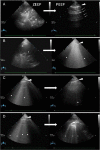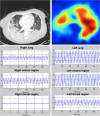Clinical review: Lung imaging in acute respiratory distress syndrome patients--an update
- PMID: 24238477
- PMCID: PMC4056355
- DOI: 10.1186/cc13114
Clinical review: Lung imaging in acute respiratory distress syndrome patients--an update
Abstract
Over the past 30 years lung imaging has greatly contributed to the current understanding of the pathophysiology and the management of acute respiratory distress syndrome (ARDS). In the past few years, in addition to chest X-ray and lung computed tomography, newer functional lung imaging techniques, such as lung ultrasound, positron emission tomography, electrical impedance tomography and magnetic resonance, have been gaining a role as diagnostic tools to optimize lung assessment and ventilator management in ARDS patients. Here we provide an updated clinical review of lung imaging in ARDS over the past few years to offer an overview of the literature on the available imaging techniques from a clinical perspective.
Figures




References
-
- Ashbaugh DG, Bigelow DB, Petty TL, Levine BE. Acute respiratory distress in adults. Lancet. 1967;17:319–323. - PubMed
-
- Camporota L, Ranieri VM. What’s new in the “Berlin” definition of acute respiratory distress syndrome? Minerva Anestesiol. 2012;17:1162–1166. - PubMed
-
- Ferguson ND, Fan E, Camporota L, Antonelli M, Anzueto A, Beale R, Brochard L, Brower R, Esteban A, Gattinoni L, Rhodes A, Slutsky AS, Vincent JL, Rubenfeld GD, Thompson BT, Ranieri VM. The Berlin definition of ARDS: an expanded rationale, justification, and supplementary material. Intensive Care Med. 2012;17:1573–1582. doi: 10.1007/s00134-012-2682-1. - DOI - PubMed
-
- Ranieri VM, Rubenfeld GD, Thompson BT, Ferguson ND, Caldwell E, Fan E, Camporota L, Slutsky AS. Acute respiratory distress syndrome: the Berlin Definition. JAMA. 2012;17:2526–2533. - PubMed
Publication types
MeSH terms
LinkOut - more resources
Full Text Sources
Other Literature Sources
Medical
Miscellaneous

